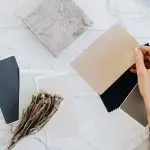Looking to bond fabric to wood like a pro? You're in the right place! Finding the best adhesive for this task can seem like searching for a needle in a haystack. But fear not, as we've got you covered with expert advice and top-notch recommendations.
Understanding the types of adhesives available, along with the factors to consider when making your choice, will set you on the path to achieving a strong and durable bond.
In this guide, you'll discover the top adhesives for fabric to wood, along with valuable application tips and maintenance advice.
So, get ready to master the art of adhesive bonding for fabric to wood like a seasoned pro!
Key Takeaways
- High-quality wood glue designed for fabric to wood bonding is recommended for the best results.
- Polyurethane-based adhesive and epoxy adhesives are excellent options for durability and flexibility, and exceptional strength respectively.
- Proper surface preparation is crucial for a strong bond between fabric and wood surfaces.
- Regular inspection and prompt maintenance are necessary to ensure the longevity of the fabric to wood adhesion.
Adhesive Types for Fabric to Wood
When bonding fabric to wood, you should consider using a high-quality wood glue specifically designed for this purpose. Wood glue offers excellent bonding strength and longevity, making it a reliable choice for adhering fabric to wood surfaces. Look for wood glues that are water-resistant and suitable for both indoor and outdoor use to ensure the longevity of your fabric-to-wood bond.
In terms of environmental impact and safety, many wood glues are formulated to be non-toxic and safe for use in various settings. Additionally, some wood glues are designed to have minimal environmental impact, making them a more eco-friendly option for your fabric-to-wood bonding needs. When selecting a wood glue, always check the product specifications and labels to ensure that it meets environmental standards and safety regulations.
Factors to Consider When Choosing Adhesive
Consider the compatibility of the adhesive with both the fabric and wood surfaces before making your selection. Surface preparation is crucial to ensure that both the fabric and wood are clean and free from any contaminants that may affect the adhesive's performance. Additionally, compatibility between the adhesive, fabric, and wood is essential to achieve a strong and lasting bond.
- Surface Preparation: Properly preparing the surfaces is key to a successful bond. Ensure that the fabric is clean and free from any coatings or finishes that could hinder adhesion. Similarly, the wood should be free from dust, grease, or old adhesive residues.
- Compatibility: Look for an adhesive that's specifically designed for bonding fabric to wood. Check the manufacturer's recommendations to ensure the adhesive is compatible with both materials for a durable and reliable bond.
- Environmental Conditions: Consider the environmental conditions, such as temperature and humidity, during the application and drying process. Some adhesives may require specific environmental conditions for optimal performance.
- Drying Time: Evaluate the drying time of the adhesive. Depending on your project timeline, you may need an adhesive with a fast or slow drying time to accommodate the application and assembly of the fabric to wood.
Top Adhesives for Fabric to Wood
To determine the top adhesives for bonding fabric to wood, assess their strength and durability for a lasting and reliable bond. Consider fabric preparation and the condition of the wood surface for successful adhesion.
One of the top adhesives for this purpose is a polyurethane-based adhesive. It offers long-term durability and flexibility, ensuring that the bond can withstand the natural movements and changes in the wood.
Additionally, epoxy adhesives are known for their exceptional strength and ability to bond various materials, including fabric to wood. These adhesives provide a reliable and durable bond that can endure the test of time.
Another top choice is a solvent-based adhesive, which is effective in bonding fabric to wood due to its strong and long-lasting adhesion.
It's important to note that regardless of the adhesive chosen, proper surface preparation, including cleaning and roughening the wood surface, is crucial for achieving a strong and lasting bond.
Application Tips for Using Adhesive
Using a bonding agent, carefully apply the adhesive to the fabric and wood surfaces, ensuring even coverage for a strong and secure bond. Proper surface preparation is essential for a successful bond. Here are some tips to help you achieve the best results:
- Clean the surfaces: Ensure that both the fabric and wood surfaces are clean and free from dust, oil, or any other contaminants. This will allow the adhesive to create a strong bond.
- Apply the adhesive evenly: Use a brush or a small roller to apply the adhesive evenly on both surfaces. This will help in achieving a uniform bond and prevent any weak spots.
- Allow proper drying time: After applying the adhesive, allow it to dry for the recommended time as per the product instructions. Rushing this step can lead to a weak bond.
- Use proper technique: Follow the application instructions provided by the adhesive manufacturer to ensure the best bonding strength.
- Press firmly: Once the adhesive is applied, firmly press the fabric onto the wood surface to ensure a strong and secure bond.
Following these tips will help you achieve a durable and long-lasting bond between fabric and wood.
Maintenance and Care for Fabric to Wood Adhesion
To ensure the longevity of your fabric to wood adhesion, regularly inspect the bonded surfaces for any signs of wear or damage. Long term durability of the bond between fabric and wood depends on proper maintenance and care. Keep an eye out for any peeling or fraying of the fabric, as well as any weakening of the bond. If you notice any issues, address them promptly to prevent further damage.
Proper cleaning is essential for maintaining the fabric to wood adhesion. Use a gentle cleaner suitable for both the fabric and the wood, ensuring it won't compromise the adhesive. Avoid using harsh chemicals or abrasive materials that could degrade the bond or damage the surfaces. Regularly dusting the bonded area can also prevent the buildup of dirt and debris that could weaken the adhesion over time.
Frequently Asked Questions
Can Fabric-To-Wood Adhesive Be Used on Outdoor Furniture?
Yes, fabric-to-wood adhesive can be used on outdoor furniture. Look for weather-resistant, durable adhesives specifically designed for fabric to wood application. Ensure proper surface preparation and follow recommended application techniques for best results.
Are There Any Special Considerations for Using Adhesive on Delicate Fabrics Like Silk or Lace?
When working with delicate fabrics like silk or lace, there are special considerations for adhesive application. Factors to account for include outdoor use, adhesive removal, painted wood, curing time, and compatibility with treated wood surfaces.
Can Fabric-To-Wood Adhesive Be Used on Treated or Painted Wood?
Yes, fabric-to-wood adhesive can be used on treated or painted wood. Make sure the adhesive is suitable for outdoor furniture and provides weather resistance if the wood will be exposed to the elements.
How Long Does It Typically Take for Fabric-To-Wood Adhesive to Fully Cure and Bond?
Typically, fabric-to-wood adhesive takes about 24 hours to fully cure and achieve maximum bonding strength. It's essential to allow sufficient time for the adhesive to set and bond securely before handling the fabric-wood combination.
Can Fabric-To-Wood Adhesive Be Easily Removed if Needed, and What Is the Best Method for Doing So?
To remove fabric-to-wood adhesive, gently peel off as much as possible. Use a fabric-safe adhesive remover for any residue. For future applications, test adhesives on a small fabric piece to ensure compatibility and apply using a thin, even layer.
- Tetron Silk Fabric: A Comprehensive Guide - June 17, 2025
- Tetron Rayon Fabric: Features and Applications - June 17, 2025
- Tetron Cotton Fabric: Uses and Benefits - June 17, 2025







